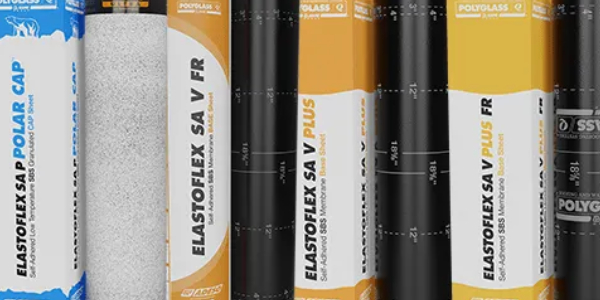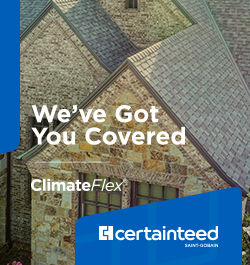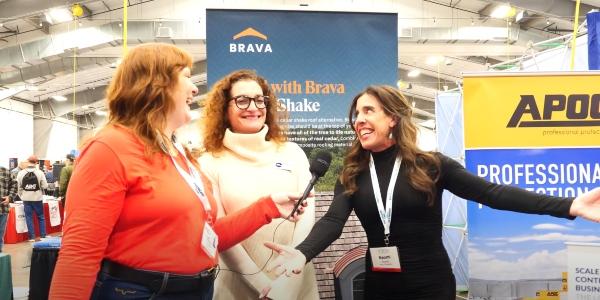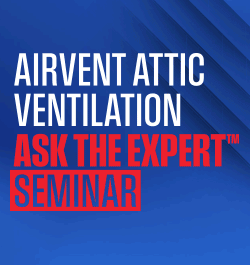Is self-adhered roofing right for your project?

By Polyglass.
Learn the basics of self-adhered, including life span, membrane options, benefits and installation methods.
Over the last few decades, manufacturers like our team at Polyglass have been developing and refining self-adhered roofing systems. Today, this type of roofing offers one of the safest and most versatile materials on the market. In addition to this, it is generally easy to install and subsequently reduces labor costs. Beyond these, there are even more benefits to using self-adhered roofing. Learn about the beginnings of self-adhered roofing and where the technology is today to understand if it’s the right option for your next project.
What is self-adhered roofing?
Self-adhered (SA) roofing is a modified bitumen membrane that uses a powerful adhesive bottom layer to stick onto a roofing surface. Modified bitumen, derived from asphalt, is the basis of SA roofing membranes, augmented by other materials like polymers. Two common types of modified bitumen membranes incorporate different materials to provide different properties, namely, atactic polypropylene (APP) and styrene-butadiene-styrene (SBS) membranes.
APP membranes are enhanced with plastics to increase their rigidity, while SBS membranes feature a form of synthetic rubber that makes them elastomeric, increasing their flexibility.
Many roofing contractors use self-adhered membranes due to their easy, quick and safe installation process. Self-adhering roofing membranes are a cost-effective alternative compared to other roofing methods and are also incredibly versatile.
How long does self-adhered roofing last?
When choosing a roofing system, one of the main factors to consider will be the roof’s longevity. Different roofing materials all have different expected lifespans. However, it isn’t necessarily as clear-cut as that.
The realistic lifespan of a roof depends on several other factors. This includes:
- The climate and weather conditions to which it will be exposed.
- How well the roof system was installed.
- How regularly the roof is maintained (roof inspections are recommended twice per annum) and the contractor used to do this.
The quality of the products and accessories — such as the roof underlayments or roof membranes – and their related warranties, are also factors to consider when looking for a roof system with longevity.
Self-adhered modified bitumen roofing membranes come into their own for their easy installation process, which reduces the risk of poor-quality application that could cause problems later.
View adeso self-adhered brochure.
How to extend the life of a roof system
In many cases, an aging roof can have its lifespan extended through products such as roof coatings, which can be made from acrylic, silicone or asphalt. Coatings are effectively applied onto the roof to repair wear and tear. If there are no glaring structural issues, a roof coating can add several years to a roof’s lifespan before a complete replacement is required.
Let’s take a look at a few common roofing types and their average expected lifespans.
-
Modified bitumen roofs: Most modified bitumen roofs, whether applied as self-adhered membranes or heat-welded membranes, have an expected lifespan of between 20 and 30 years. With good maintenance, this can be extended even further.
Thankfully, modified bitumen roofs, especially self-adhered ones, are perhaps the easiest type of roof to keep in good condition. Polyglass self-adhering roofing membranes come with a 10–30-year warranty.
-
Asphalt roofs: These roofs are generally expected to last between 15 to 20 years. These roofs are easy to install and maintain and are known for their durability.
-
Metal roofs: They will usually last for around 30 to 45 years. However, they are often expensive and can be adversely affected by heat and other weather conditions. They also require underlayment under the metal to provide vapor and water resistance.
-
PVC roofs: Polyvinyl chloride (PVC) roofing systems are expected to survive for around 20 to 30 years. They are fairly durable but will often need repairs after about 10 years and don’t stand up well to cold conditions.
-
TPO single-ply roofs: This type of roof is made from thermoplastic polyolefin and has a predicted lifespan of between 15 and 20 years. They are extremely susceptible to wear and tear because of their single-layer construction, reducing their realistic lifespan to around 10 years.
Polyglass self-adhered membranes
Before self-adhering roofing emerged, modified bitumen roofs were often installed using potentially unsafe methods such as torch-down roofing. This all changed in the 1990s when Polyglass USA introduced the first-ever self-adhering roofing products to the United States — made with patented ADESO® Self-Adhered Technology.
ADESO membranes have durable dual-compound APP or SBS surface layers on the weathering side and a powerful adhesive bottom layer for easy installation.
This technology is available throughout Polyglass’ line of membranes and underlayments, with a choice of different surface options to suit a variety of different roofing projects. ADESO Technology makes these membranes incredibly safe and easy to install, helping contractors save time and money. An ADESO roofing system gives your customers a durable roofing system that they can depend on.
There are several standout features built into all ADESO membranes. Polyglass’ innovative FASTLap® technology allows for quick and easy installation thanks to granule-free end laps, while SEALLap® Ultra creates strong monolithic watertight seals to prevent leaks and other water damage.
Due to its powerful adhesive bottom layer, self-adhered roofing is quick and easy to install. It can be installed as a single or multi-ply system, on various surfaces, including concrete and wood, and can be fixed on top of roofing insulation.
Installing a two-ply self-adhered membrane
Two-ply roofing membrane systems consist of a base sheet with a cap sheet on top. Before installation, the surface is cleaned thoroughly while the membrane rolls are left to acclimatize.
Once the surface is prepared, a self-adhering base sheet, such as Polyglass’ Elastobase product, is cut into manageable lengths and applied to the roof. This is done by lining the strip up and removing the protective film covering the adhesive bottom layer. The membrane is then pressed into place.
Once a row of the membrane has been laid, pressure is applied in the form of a roller to help make sure that the base sheet fully adheres to the roof. The rest of the base sheet is laid in this way. Once the entire base sheet is down, a middle layer of roofing membrane like Polyglass’ Elastoflex SA V can be installed in the same way.
To finish the roof, a cap sheet with a granulated weathering surface, such as Polyglass’ Polyflex® SA P APP cap sheet, is applied in the same manner as the other layers.
Benefits of self-adhered membranes
Self-adhered roofing comes with a range of benefits that make it a great choice for most roofing projects. Let’s take a look at some of the advantages of installing this type of roofing system:
-
Durability: Roofing systems made with self-adhered membranes are extremely durable and can stand up to a variety of weather conditions. Even with basic maintenance, self-adhered membranes can last at least 20 to 30 years, and they are easy to repair should any problems occur. Their lifespan can be extended further through the use of products such as silicone coatings.
-
Ease of installation: This is the biggest advantage of choosing self-adhering membranes. Thanks to their powerful adhesive layers, self-adhered roofing membranes are extremely quick and easy to install, especially those featuring Polyglass ADESO and FASTLap technologies. In a direct comparison, a Polyglass self-adhered roof can be installed two hours faster than the equivalent torch-down roof.
-
Safety: Self-adhered roofing membranes are also one of the safest types of roofs to install. They do not require the use of open flames like torch-down roofs do. This eliminates the significant risk of fire and means that no toxic fumes are produced during the installation process.
-
Versatility: Self-adhered membranes can be augmented with a range of extra features to adapt to specific roofing conditions. Some of Polyglass’ most versatile SA membranes include the highly reflective Polyfresko®G SA cap sheets and the Polyfresko® G SBS SA granulated cap sheets.
-
Weather protection: Roofing systems featuring self-adhering technology also stand up well against various weather conditions thanks to strong seals. Polyglass ADESO membranes feature SEALLap Ultra, designed to create powerful monolithic watertight seals along each roof seam.
Original article source: Polyglass
Learn more about Polyglass in their Coffee Shop Directory or visit www.polyglass.us.























Comments
Leave a Reply
Have an account? Login to leave a comment!
Sign In